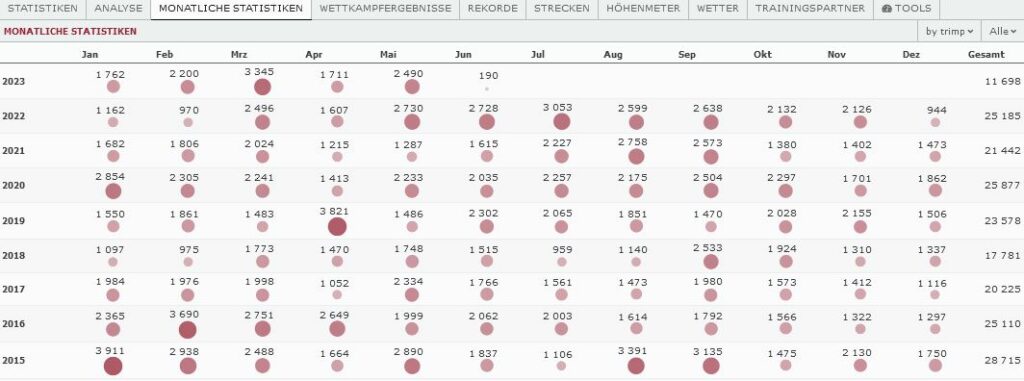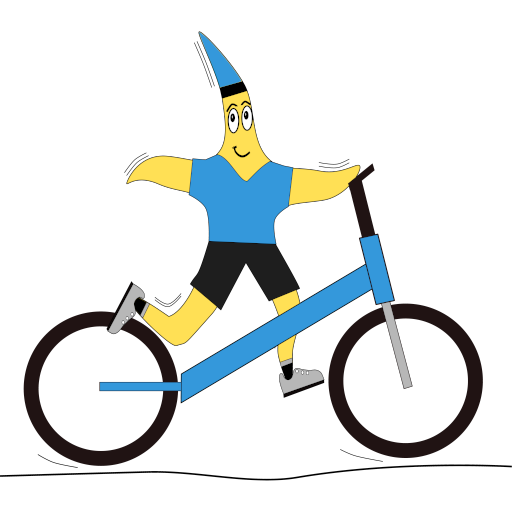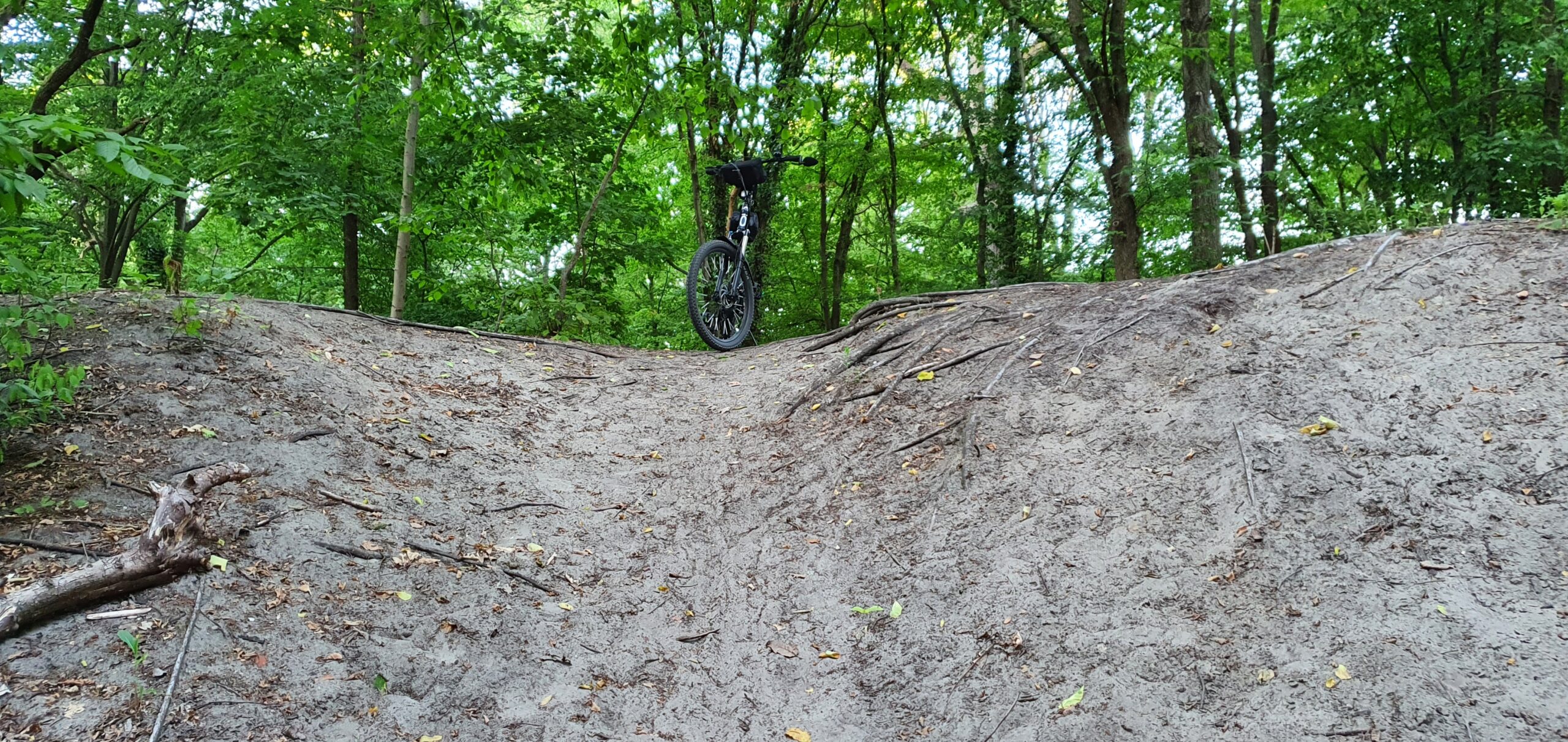Zuletzt aktualisiert | last modified: 21. April 2024
Startseite | English | How to train with an ElliptiGO?

Inhalt | Content
Generally
General recommendations on how to train with an ElliptiGO are naturally difficult. For example, the level of fitness of the trainee plays a decisive role. Below I describe my own experiences and methods, which focus on fitness, not on speed and certainly not on competition.
All three models that I own are strenuous in a way and therefore perfectly fulfill their purpose as a training device. On the classifieds market, you can sometimes find offers for stand up versions, with the selling reason that it is too strenuous. All ElliptiGO bikes can of course be rid comfortably and less ambitiously. But if you are looking for a non-strenuous bike or want to get to your destination without sweating, you should rather look around for e-bikes. By the way, in the US battery/ motor kits for all ElliptiGO models are available. I haven’t seen such an offer anywhere in Europe. I don’t really need one myself right now.
Theory
The manufacturer advertises that, according to a study by the University of California, you would burn an average of 33% more calories than riding a conventional bicycle at the same speed. The study also found that riding at 16.5 miles per hour (about 27 kilometers per hour) on an ElliptiGO is just as strenuous as running at a pace of 8 minutes per mile (about 5 minutes per kilometer).
Practice
I can’t really judge whether this is somewhat true in practice. At least I haven’t noticed any adverse effects compared to running since I switched.
In my opinion, training with an ElliptiGO can hardly be compared to „normal“ cycling. Although the 11R in particular can easily reach high speeds, attempts to keep up with sporty racing cyclists over the long term will fail, mainly due to the different driving technique and the upright position. But an ElliptiGo is no racing bike, but an instrument for maximum training effect with minimum time.
Physically, I feel much fitter than before. And you do the core training – at least partially – at the same time. From my point of view, all three models are therefore also suitable for runners who are looking for a supplementary training aid.
In terms of the training effect, the SUB and MSUB are quite similar to me. In hilly terrain, I find the SUB subjectively more strenuous than the 11R, although the 11R is significantly heavier.
However, any desired training effect can be achieved with all three models by choosing an appropriate route and training duration.
The 11R is closer to running and definitely more knee-friendly, especially over longer distances. However, it is almost exclusively suitable for paved paths.
In practice, I have found that I often spend a little longer per training session than I did when running. But this is less due to the requirement than to the fun factor, which I feel is higher with the ElliptiGO than with running, not least because of the significantly increased range. It’s also nice to be able to train longer without causing problems in the joints.
Safety
The risk of accidents for cyclists is generally higher than for people on foot, even if you ride slowly.
So far I’ve only had a slight fall with an ElliptiGO because I misjudged a curb under leaves in autumn. That was at walking speed and would have happened to me the same way with any other bike.
It’s very easy to get started with the driving technique of an ElliptiGO. However, it is more fragile than a standard bicycle. This is due to the design, the different driving position and with the 3C, 8C, 11R and SUB because of the small 20-inch wheels.
You don’t have to ride fast to train efficiently with an ElliptiGO. It is more a question of the optimal training technique using the available terrain than of speed.
Driving off-road with an MSUB requires additional practice. Here you have to try individually on inclines and changing ground by actively shifting the center of gravity. But that’s not much different with a traditional mountain bike.
The ElliptiGO offered by the German importer basically meet the requirements of the StVZO (German road traffic act) for riding bicycles in daylight. So you have two independent brakes, a bell, the white reflector at the front, a red one at the rear and the pedals of the Stand Up Bikes yellow reflectors. Spoke reflectors are included. For outdoor training during twilight and darkness, you have to get your own front and rear lights.
Hand signal
At first it is difficult to take your hands off the handlebars, similar to what is the case with a city scooter. I recommend beginners to first practice in a safe area away from traffic until you can drive safely.
With the stand up models it is easier to give a hand signal if you first put the pedal on the side of the „turn hand“ in the lowest position. On the elliptical models, put the turn-side pedal in the front position.
It might sound a bit complicated, but it isn’t. A manufacturer’s video clearly explains how it’s done…
After a little practice, an ElliptiGO is just as safe to ride as a bicycle. But driving hands-free should be avoided.
Brakes
In my experience, the center of gravity is rather further forward when driving. This must be taken into account when braking. This does not have such a strong effect on the long stride models because they are heavier at the back. With the stand up variants, however, it does play a role, especially if you carry bags or a heavy lock on the handlebars or front frame and on unpaved roads when driving downhill. During „emergency braking“ you should actively shift your body weight backwards. You can practice that too.
The brake levers on my SUB were swapped compared to the other two bikes. I corrected that so that all bikes have the front brake on the left and the rear brake on the right.
Training technique
At the beginning I tried to ride the ElliptiGO bikes according to speed or pace like in a running endurance unit. That pushed me to my limits very quickly, mainly on hilly routes.
I now only ride based on my cadence and heart rate, regardless of my speed.
My weekly training rhythm is roughly based on running. During the week, I usually do a shorter, faster sprint unit (up to about 20 kilometers) and a medium-length endurance unit (up to about 35 kilometers). On the weekend – if I have the time – I add a slower but longer ride (50 to 60 kilometers). This rhythm can also be completed on the indoor trainer. But that’s not nearly as much fun as outdoors.
For training that is comparable to endurance running, I try to maintain a cadence of around 60 to 70 rounds per minute, regardless of the terrain, as long as my pulse doesn’t get too high and the traffic and leg muscles allow it.
On hilly routes, I train intervals almost automatically through the terrain. On the flat, I sometimes practice fartlek/ Speed play, which also works quite well with an ElliptiGO.
During my training sessions, I ride distance between 20 and 60 kilometers. In my hilly homearea, there can be up to 1000 meters of ascent per training session.
On inclines anyway, but also on longer straight stretches, it is no problem to get your pulse up to the maximum range with all bikes. My training evaluation has shown that I achieve slightly higher maximum and average plus values with the ElliptiGO than before with the running units.
Training comparison running and ElliptiGO
As a previous runner, I was wondering how I could compare my past and future workouts. The distance is of course not very suitable.
The manufacturer recommends focusing on perceived exertion, heart rate, or exercise duration. But I do not find the latter really useful either.
Many cyclists rely on Strava for training documentation. But this isn’t my first choice because I do not need all the „community stuff“, ElliptiGO isn’t defined as a separate sport there – although users have asked for it several times, and training with an ElliptiGO is not comparable to classic cycling. Comparing your segment performance at Strava to cyclists can be rather frustrating.
As a runner, I have been documenting my training sessions with Runalyze for many years and I do the same now with the ElliptiGO. I only use Strava as an „intermediate station“ to sync from my bike computer to Runalyze.
You can read more about my training recording in the article Useful accessories.
Sports can be defined individually in Runalyze. I have created a sport „ElliptiGO“ with the two training types „Outdoor“ (GO) and „Indoor“ (GI)“. So I can now compare them with the previous runs – and other sports. For this purpose, I use a feature in Runalyze to calculate the training pulse (TRIMP). This is a method of quantifying the training load based on heart rate and duration of an exercise. The method uses a heart rate reserve that takes into account both, resting heart rate and maximum heart rate. In addition, a gender-specific weighting factor. The TRIMP is sufficiently suitable for me, to view the entirety of my training sessions over the years without any breaks…

Indoor training with an ElliptiGO
With the ElliptiGO Fluid 365 trainer, which is compatible with all current models, there is a way to avoid bad weather. This makes efficient indoor training possible.
Since the Fluid 365 is not smart compared to many trainers on the market and the relevant indoor sports apps can therefore only be used to a limited extent, the training is a bit boring.
Due to the frame geometry and the loads when riding on indoor trainers, there are some things to consider.
More on the subject can be found in the article indoor workout.
Clothing on an ElliptiGO
Apart from cycling jackets for winter and rain, which are a little better sealed than running jackets, cycling gloves and helmets, I don’t wear any special cycling clothing when doing sports with the ElliptiGO. Because of the movement and position on the bike, running gear is much better for ElliptiGO.
I also continue to wear my running shoes, but they last much longer now because their cushioning is less stressed.
In winter I use layered clothing. Instead of running shoes, I wear half-height hiking shoes and, if necessary, windproof thermal socks at low temperatures. Warm gloves that dry easily after the workout are essential. You can also find suitable products in motorcycle or winter sports accessories. I’ve already trained outdoors for about two hours in temperatures of around minus five degrees Celsius without getting too cold.
Startseite | English | How to train with an ElliptiGO?


